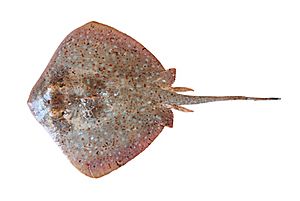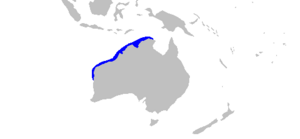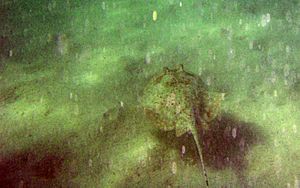Ningaloo maskray facts for kids
Quick facts for kids Ningaloo maskray |
|
|---|---|
 |
|
| Conservation status | |
| Scientific classification | |
| Genus: |
Neotrygon
|
| Species: |
ningalooensis
|
 |
|
| Range of the Ningaloo maskray | |
The Ningaloo maskray (Neotrygon ningalooensis) is a type of stingray. It lives along the northwestern coast of Australia. This ray can grow up to 30 cm (12 in) wide. It has a special diamond shape with a blunt nose and rounded corners. Its tail looks like a whip and has folds on both the top and bottom.
What makes this ray stand out is its amazing color pattern. It has many small, bright orange spots and slightly bigger, fuzzy pale blue spots. These spots are on a yellowish-brown background.
The Ningaloo maskray lives in shallow coastal waters, usually less than 5 meters (16 ft) deep. It prefers to live on reddish sand near reefs. Its unique colors help it blend in perfectly with its surroundings, like a natural camouflage. It can even bury itself deeper than other maskrays because its eyes stick out.
The International Union for the Conservation of Nature (IUCN) has listed this species as Data Deficient. This means we don't have enough information about how many there are. Luckily, fishing doesn't seem to harm them much. However, losing their special sandy habitat could be a problem for them.
Contents
Discovering the Ningaloo Maskray
The Ningaloo maskray was first seen during a study of the sharks and rays in Ningaloo Marine Park. This park is where the ray gets its name. Scientists Peter Last, William White, and Melody Puckridge officially described it in 2010. They wrote about it in a science magazine called Aqua.
The first examples of this ray that scientists studied were two adult males. They were about 30 cm (12 in) and 29 cm (11 in) wide. Both were found near Coral Bay in Western Australia.
Scientists also study the DNA of these rays to understand how they are related to other species. They found that the Ningaloo maskray is one of the oldest types in its group. Rays from Coral Bay and Shark Bay seem to have different DNA. This might mean they are different types of Ningaloo maskrays, but more study is needed. This difference could be because their populations were separated by changes in sea level a very long time ago.
What Does the Ningaloo Maskray Look Like?
The Ningaloo maskray has a body that is shaped like a diamond. It is a bit wider than it is long. The front edges of its body are mostly straight, and its outer corners are rounded. Its snout, or nose, is short and rounded.
Its eyes are large and stick out, which is a special feature. Behind the eyes are large, crescent-shaped holes called spiracles. These help the ray breathe. Below its nose, there's a skin flap that is split into two parts and has a fringed edge. The mouth is small with shallow grooves at the corners. Inside the mouth, there are small bumps called papillae, and two longer ones on the floor of the mouth. Its teeth can be long and pointy or short and blunt. It also has five pairs of S-shaped gill slits. Its pelvic fins are narrow and shaped like triangles.
The tail is thin and whip-like. It has two very slender stinging spines on top. The tail is wide and flat at the base, then gets thinner past the stings. Behind the stings, there are fin folds on both the top and bottom of the tail. The one on the bottom is deeper and shorter than the one on top.
The skin of the ray is mostly smooth. It only has a few small thorns in a line behind its spiracles. The top of its body is yellowish-brown. It gets darker towards the edges. It has many dark orange and light blue spots. The orange spots are smaller and clearer, especially in the middle of the body. The blue spots are larger, less clear, and spread out evenly. Like other maskrays, it has a darker, mask-like pattern across its eyes, but it can be hard to see. The tail has black and white bands behind the stings. The underside of the ray is pale. The largest Ningaloo maskray found was about 30 cm (12 in) wide.
Where the Ningaloo Maskray Lives
This ray is found only in northwestern Australia. It lives from Shark Bay in Western Australia all the way to the Gove Peninsula in the Northern Territory.
The Ningaloo maskray is a bottom-dwelling species. This means it lives on the seafloor. It seems to be very picky about where it lives. It prefers areas with fine reddish sand that are close to reefs. It lives in shallow coastal waters, less than 5 meters (16 ft) deep.
Life and Habits
The Ningaloo maskray has eyes that stick out more than other maskrays. This special feature allows it to bury itself deeper in the sand or mud, called the substrate. Even when buried deep, it can still see what's happening around it. In its favorite sandy habitat, its unique coloring helps it blend in very well. This makes it hard for predators to spot it.
Protecting the Ningaloo Maskray
Because the Ningaloo maskray lives in very shallow waters, it usually avoids being caught by fishing boats. However, its very specific habitat needs mean it could be at risk if its home is damaged. This is called habitat degradation.
Luckily, some of the areas where this ray lives are protected. These include the World Heritage Sites of Ningaloo Reef and Shark Bay. The International Union for the Conservation of Nature (IUCN) is still working to gather enough information to fully understand how many Ningaloo maskrays there are and how well they are doing. For now, they are listed as "Data Deficient."
Images for kids





